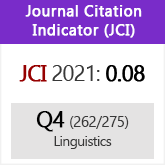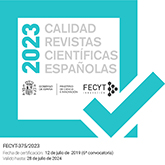The contribution of prosody to foreign accent: A study of Spanish as a foreign language
DOI:
https://doi.org/10.3989/loquens.2017.041Keywords:
foreign accent, prosody, delexicalization, L2 Spanish, task typeAbstract
The aim of this study is to analyze the contribution of prosody on the perception of foreign accent by Brazilian learners of Spanish. The data were collected from 15 participants and a control group of 5 native Spanish speakers. A perceptual test was performed with two different speech styles (reading and storytelling) and with delexicalized and natural speech. The speech production was judged by 24 native Spanish subjects. First, they had to determine the nationality of the speaker by listening to the delexicalized excerpts in Spanish (storytelling). After that, the listeners used a continuous scale to rate the excerpts (reading and storytelling) for the degree of foreign accent in Spanish. The results suggest that it is possible to identify foreign accent only with the prosodic information provided in the delexicalized stimuli, i.e., f0, duration, and overall intensity. In addition, the perceptual test allowed us to assess the degree of foreign accent of each subject while revealing the great variability of their production. Finally, concerning the external data, the following factors predicted foreign accent among the learners: gender, length of residence in Spain, formal language instruction in Brazil, age of arrival in Spain, and reported use of Brazilian Portuguese in Spain. These results confirm the crucial role of naturalistic learning of a foreign language, as shown by previous studies.
Downloads
References
Aguilar, A. S. (2004). Don Quijote. Adaptación, notas y actividades. Barcelona: Vicens Vives.
Anderson-Hsieh, J., & Koehler, K. (1988). The effect of foreign accent and speaking rate on native speaker comprehension. Language Learning, 38(4), 561-613. https://doi.org/10.1111/j.1467-1770.1988.tb00167.x
Best, C. T. (1995). A direct realist view of cross-language speech perception. In W. Winifred (Ed.), Speech perception and linguistic experience: Issues in cross-language research (pp. 171-204). Baltimore, MD: York.
Boula de Mareüil, P., & Vieru-Dimulescu, B. (2006). The contribution of prosody to the perception of foreign accent. Phonetica, 63(4), 247-267. https://doi.org/10.1159/000097308 PMid:17293645
Carey, M. D., Mannell, R. H., & Dunn, P. K. (2011). Does a rater's familiarity with a candidate's pronunciation affect the rating in oral proficiency interviews? Language Testing, 28(2), 201-219. https://doi.org/10.1177/0265532210393704
Dellwo, V. (2010). Influences of speech rate on the acoustic correlates of speech rhythm: An experimental phonetic study based on acoustic and perceptual evidence (PhD Thesis). University of Bonn, Germany.
Derwing, T. M., & Munro, M. J. (2005). Second language accent and pronunciation teaching: A research-based approach. Tesol Quarterly, 39(3), 379-397. https://doi.org/10.2307/3588486
Díaz-Campos, M. (2004). Context of learning in the acquisition of Spanish second language phonology. Studies in second language acquisition, 26(2), 249-273. https://doi.org/10.1017/S0272263104262052
Ellis, R. (1994). The study of second language acquisition. Oxford, UK: Oxford University.
Escudero, P. (2005). Linguistic perception and second language acquisition: Explaining the attainment of optimal phonological categorization (PhD Thesis). Netherlands Graduate School of Linguistics. University of Utrecht, Netherlands.
Flege, J. E. (1984). The detection of French accent by American listeners. The Journal of the Acoustical Society of America, 76(3), 692-707. https://doi.org/10.1121/1.391256 PMid:6491043
Flege, J. E. (1988). Factors affecting degree of perceived foreign accent in English sentences. The Journal of the Acoustical Society of America, 84(1), 70-79. https://doi.org/10.1121/1.396876 PMid:3411056
Flege, J. E. (1993). Production and perception of a novel, secondlanguage phonetic contrast. The Journal of the Acoustical Society of America, 93(3), 1589-1608. https://doi.org/10.1121/1.406818 PMid:8473613
Flege, J. E. (1995). Second language speech learning: Theory, findings, and problems. In W. Winifred (Ed.): Speech perception and linguistic experience: Issues in cross-language research (pp. 233-277). Baltimore, MD: York.
Flege, J. E., & Hillenbrand, J. (1984). Limits on phonetic accuracy in foreign language speech production. The Journal of the Acoustical Society of America, 76(3), 708-721. https://doi.org/10.1121/1.391257
Flege, J. E., Munro, M. J., & MacKay, I. R. (1995). Factors affecting strength of perceived foreign accent in a second language. The Journal of the Acoustical Society of America, 97(5), 3125-3134. https://doi.org/10.1121/1.413041 PMid:7759652
Flege, J. E., Yeni-Komshian, G. H., & Liu, S. (1999). Age constraints on second-language acquisition. Journal of memory and language, 41(1), 78-104. https://doi.org/10.1006/jmla.1999.2638
Goldstein, L., & Browman, C. P. (1986). Representation of voicing contrasts using articulatory gestures. Journal of Phonetics, 14, 339-342.
Hahn, L. D. (2004). Primary stress and intelligibility: Research to motivate the teaching of suprasegmentals. TESOL Quarterly, 38(2), 201-223. https://doi.org/10.2307/3588378
Holm, S. (2008). Intonational and durational contributions to the perception of foreign-accented. An experimental phonetic investigation (PhD Thesis). Norwegian University of Science and Technology, Norway.
Huang, B., Alegre, A., & Eisenberg, A. (2016). A cross-linguistic investigation of the effect of raters' accent familiarity on speaking assessment. Language Assessment Quarterly, 13(1), 25-41. https://doi.org/10.1080/15434303.2015.1134540
Jilka, M. (2000). The contribution of intonation to the perception of foreign accent: Identifying intonational deviations by means of F0 generation and resynthesis (PhD Thesis). Institute for Natural Language Processing, University of Stuttgart, Germany.
Kuhl, P. K. (1994). Learning and representation in speech and language. Current Opinion in Neurobiology, 4(6), 812-822. https://doi.org/10.1016/0959-4388(94)90128-7
Kuhl, P. K. (2000). A new view of language acquisition. Proceedings of the National Academy of Sciences, 97(22). https://doi.org/10.1073/pnas.97.22.11850 PMid:11050219 PMCid:PMC34178
Major, R. G. (2001). Foreign accent: The ontogeny and phylogeny of second language phonology. Mahwah, NJ: Lawrence Erlbaum.
Munro, M. J. (1995). Nonsegmental factors in foreign accent. Studies in Second Language Acquisition, 17(01), 17-34. https://doi.org/10.1017/S0272263100013735
Munro, M. J., & Derwing, T. M. (1994). Evaluations of foreign accent in extemporaneous and read material. Language Testing, 11(3), 253-266. https://doi.org/10.1177/026553229401100302
Munro, M. J., Derwing, T. M., & Morton, S. L. (2006). The mutual intelligibility of L2 speech. Studies in Second Language Acquisition, 28, 111-131. https://doi.org/10.1017/S0272263106060049
Piske, T., MacKay, I. R., & Flege, J. E. (2001). Factors affecting degree of foreign accent in an L2: A review. Journal of Phonetics, 29(2), 191-215. https://doi.org/10.1006/jpho.2001.0134
Purcell, E. T., & Suter, R. W. (1980). Predictors of pronunciation accuracy: A reexamination. Language Learning, 30(2), 271-287. https://doi.org/10.1111/j.1467-1770.1980.tb00319.x
R Development Core Team (2008). R: A language and environment for statistical computing. Vienna, Austria: R Foundation for Statistical Computing.
Sanz Marco, C. (2005). Adaptaciones escolares de Don Quijote de la Mancha: Criterios y modalidades. In S. M. Saz (Ed.), Actas del XL Congreso Internacional de la Asociación Europea de Profesores de Español. 400 a-os de Don Quijote: Pasado y perspectivas de futuro (pp. 197?209). Universidad de Valladolid. Retrieved from https://cvc.cervantes.es/ensenanza/biblioteca_ele/aepe/pdf/congreso_40/congreso_40_22.pdf
Skehan, P. (2001): Tasks and language performance assessment. In M. Bygate, P. Skehan, & M. Swain (Eds.), Researching pedagogic tasks, second language learning, teaching and testing (pp. 167-185). Harlow: Longman.
Skehan, P. & Foster, P. (1997). Task type and task processing conditions as influences on foreign language performance. Language Teaching Research, 1, 185-211. https://doi.org/10.1177/136216889700100302
Sonntag, G. P., & Portele, T. (1998). PURR–A method for prosody evaluation and investigation. Computer Speech & Language, 12(4), 437-451. https://doi.org/10.1006/csla.1998.0107
SurveyGizmo (n. d.). [Online software]. Retrieved from http://www.surveygizmo.com
Suter, R. W. (1976). Predictors of pronunciation accuracy in second language learning. Language Learning, 26(2), 233-253. https://doi.org/10.1111/j.1467-1770.1976.tb00275.x
Thompson, I. (1991). Foreign accents revisited: The English pronunciation of Russian immigrants. Language Learning, 41(2), 177-204. https://doi.org/10.1111/j.1467-1770.1991.tb00683.x
Wagner, P. (2004). Praat script: purr2004 [Computer software]. Retrieved from http://web.uvic.ca/~tyoon/resource/purr_filtering. praat
Vaissière, J., & Boula de Mareüil, P. B. (2004). Identifying a language or an accent: From segments to prosody. In Workshop MIDL (pp. 1?4).
Vieru-Dimulescu, B., & Boula de Mareüil, P. (2005). Contribution of prosody to the perception of a foreign accent: A study based on Spanish/Italian modified speech. In V. Hazan & P. Iverson, PSP2005: ISCA Workshop on Plasticity in Speech Perception (pp. 66–69).
Winke, P., & Gass, S. (2013). The influence of second language experience and accent familiarity on oral proficiency rating: A qualitative investigation. TESOL Quarterly, 47(4), 762-789. https://doi.org/10.1002/tesq.73
Published
How to Cite
Issue
Section
License
Copyright (c) 2018 Consejo Superior de Investigaciones Científicas (CSIC)

This work is licensed under a Creative Commons Attribution 4.0 International License.
© CSIC. Manuscripts published in both the printed and online versions of this Journal are the property of Consejo Superior de Investigaciones Científicas, and quoting this source is a requirement for any partial or full reproduction.All contents of this electronic edition, except where otherwise noted, are distributed under a “Creative Commons Attribution 4.0 International” (CC BY 4.0) License. You may read here the basic information and the legal text of the license. The indication of the CC BY 4.0 License must be expressly stated in this way when necessary.
Self-archiving in repositories, personal webpages or similar, of any version other than the published by the Editor, is not allowed.















